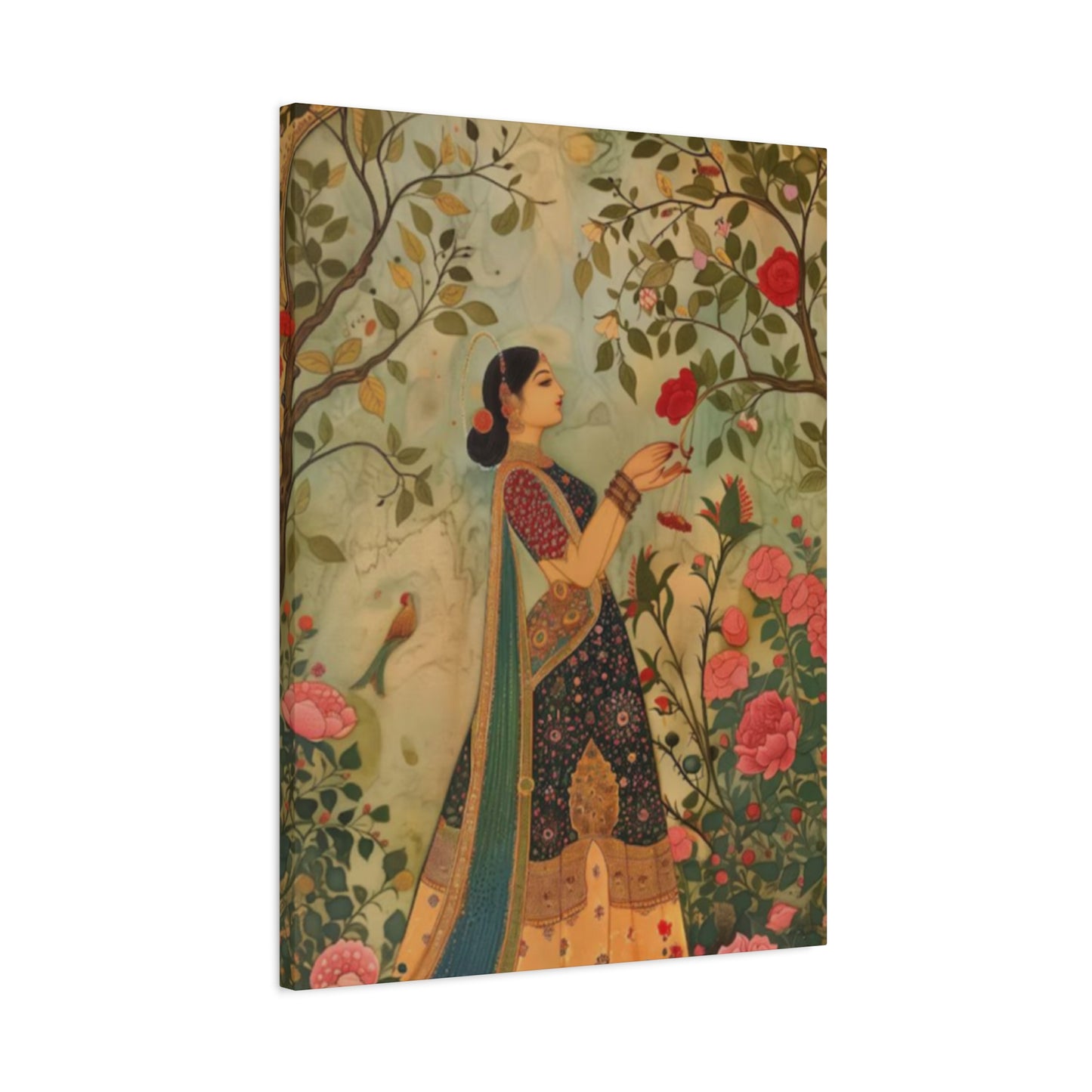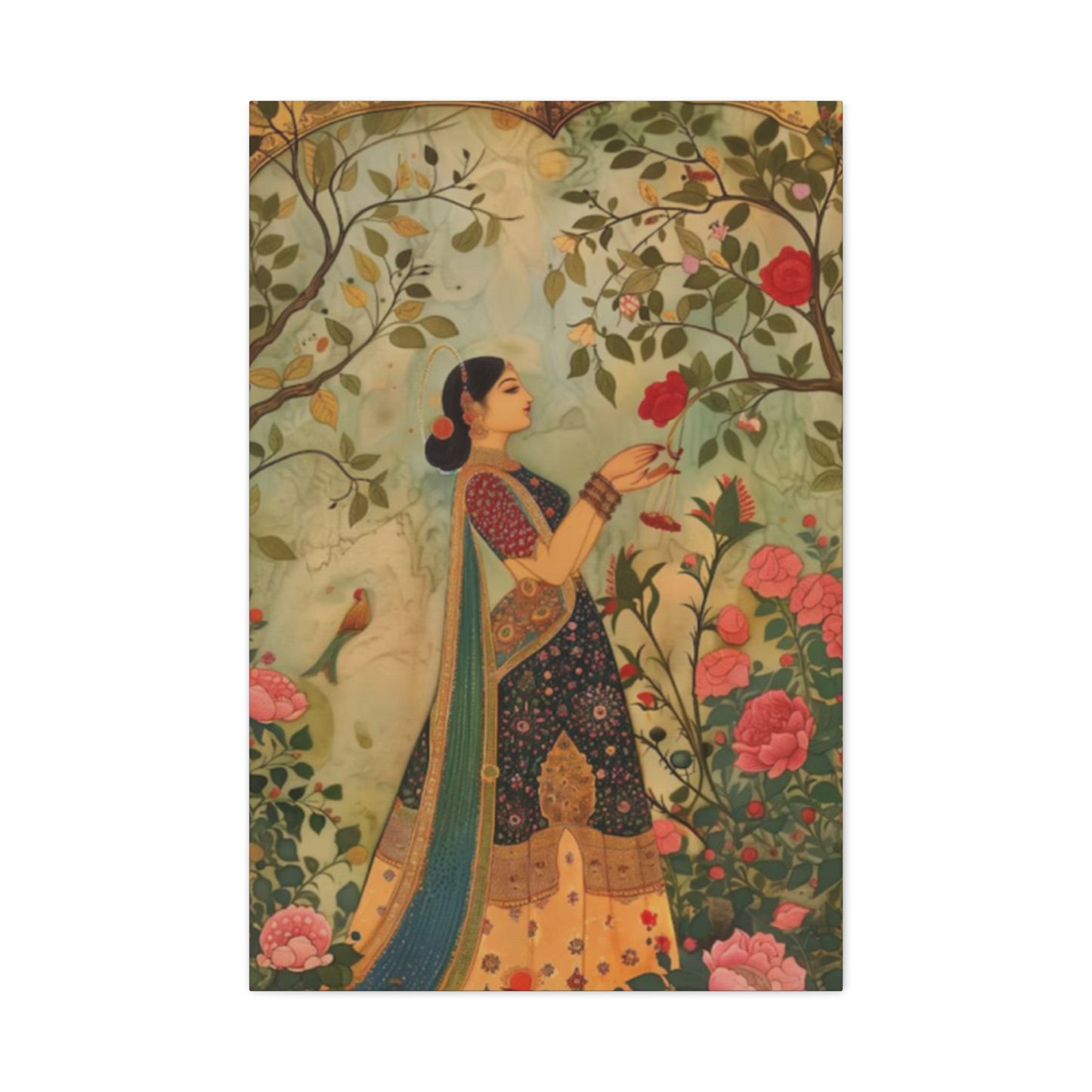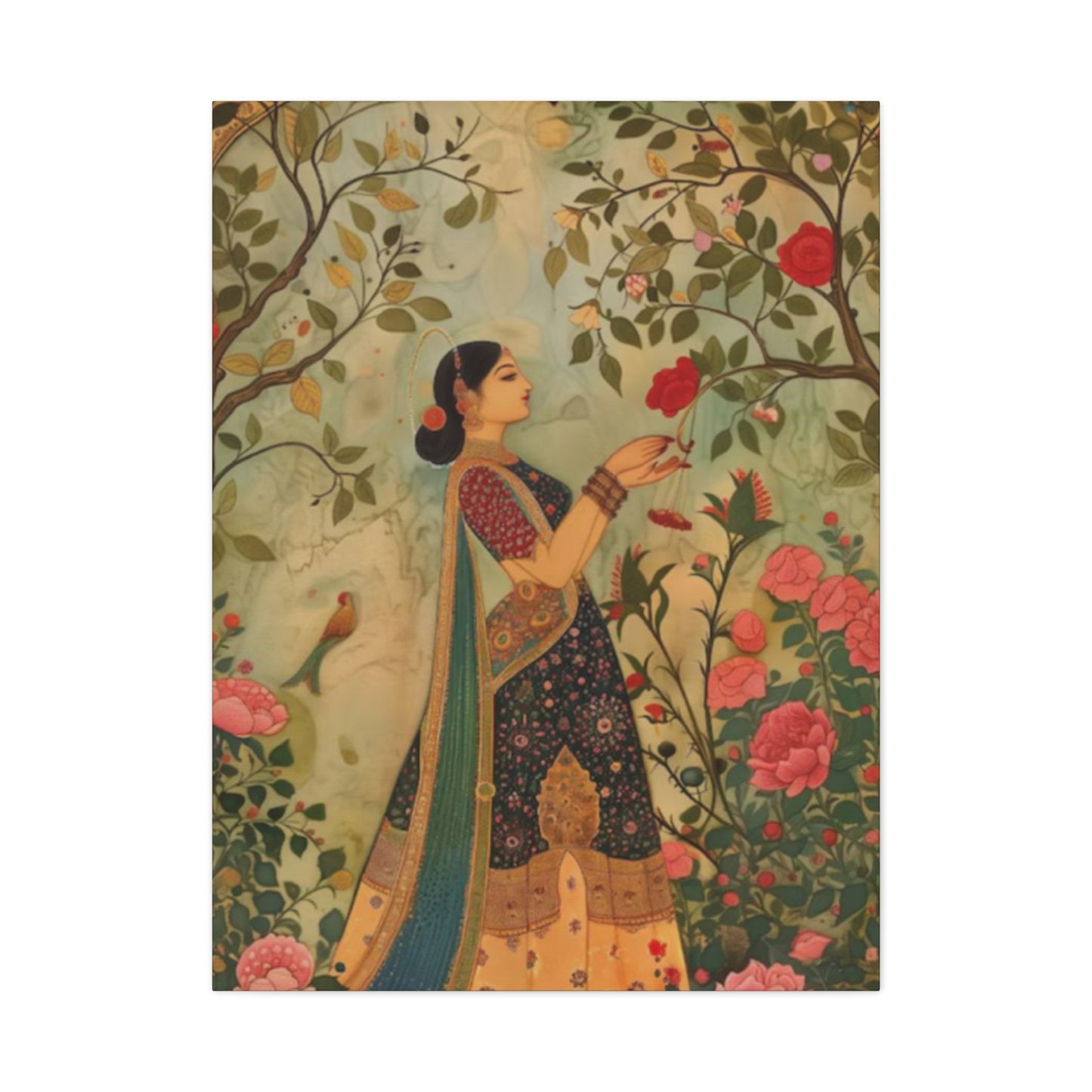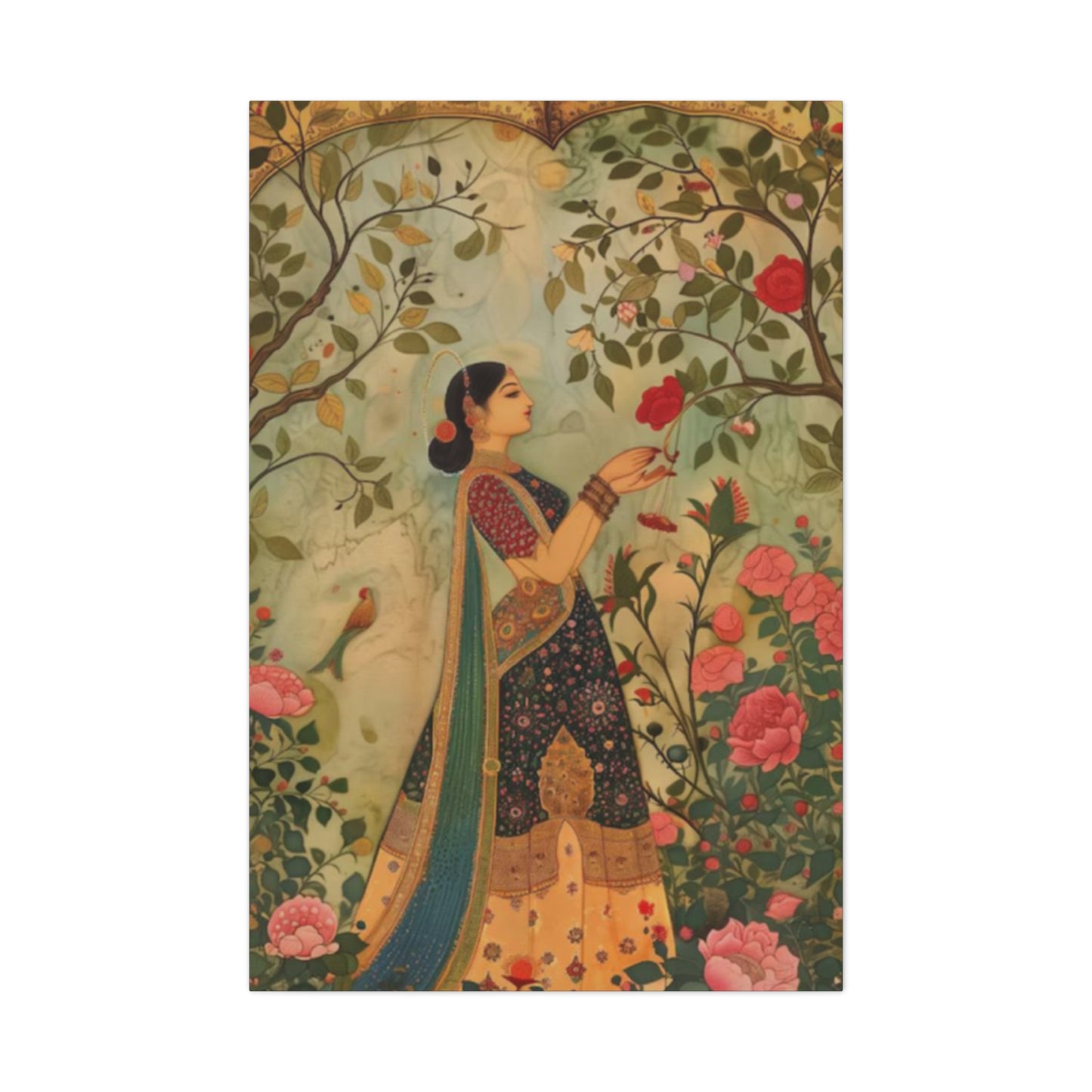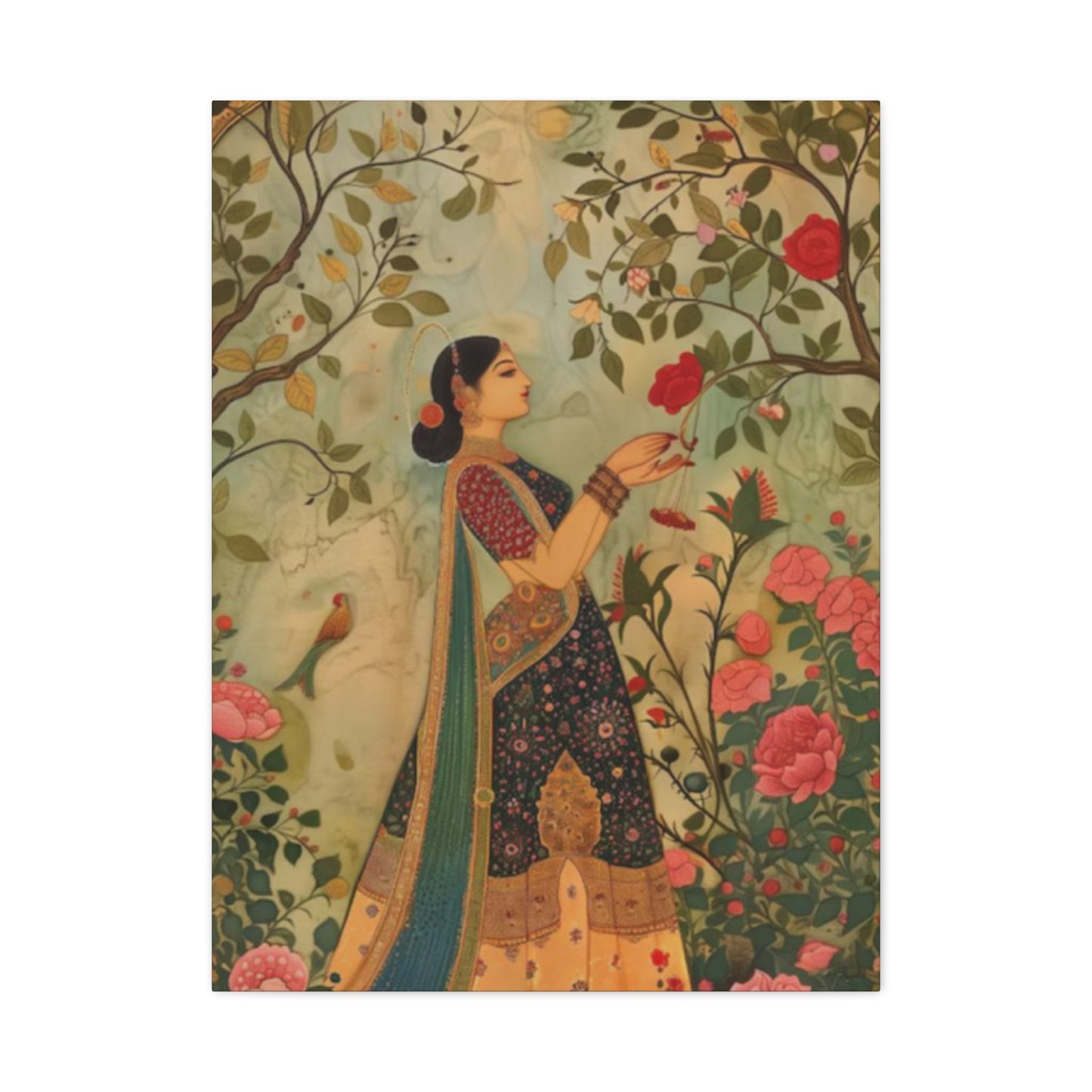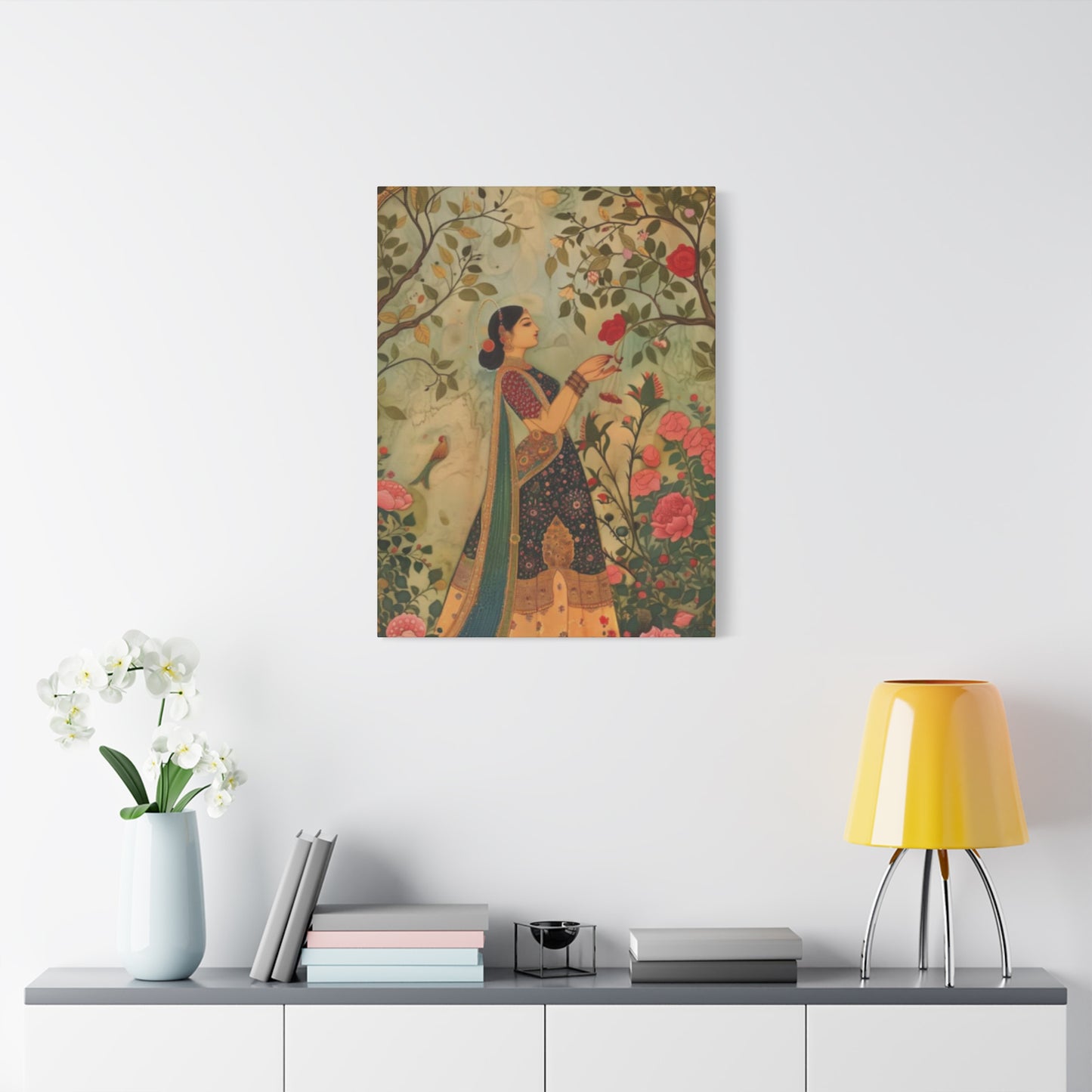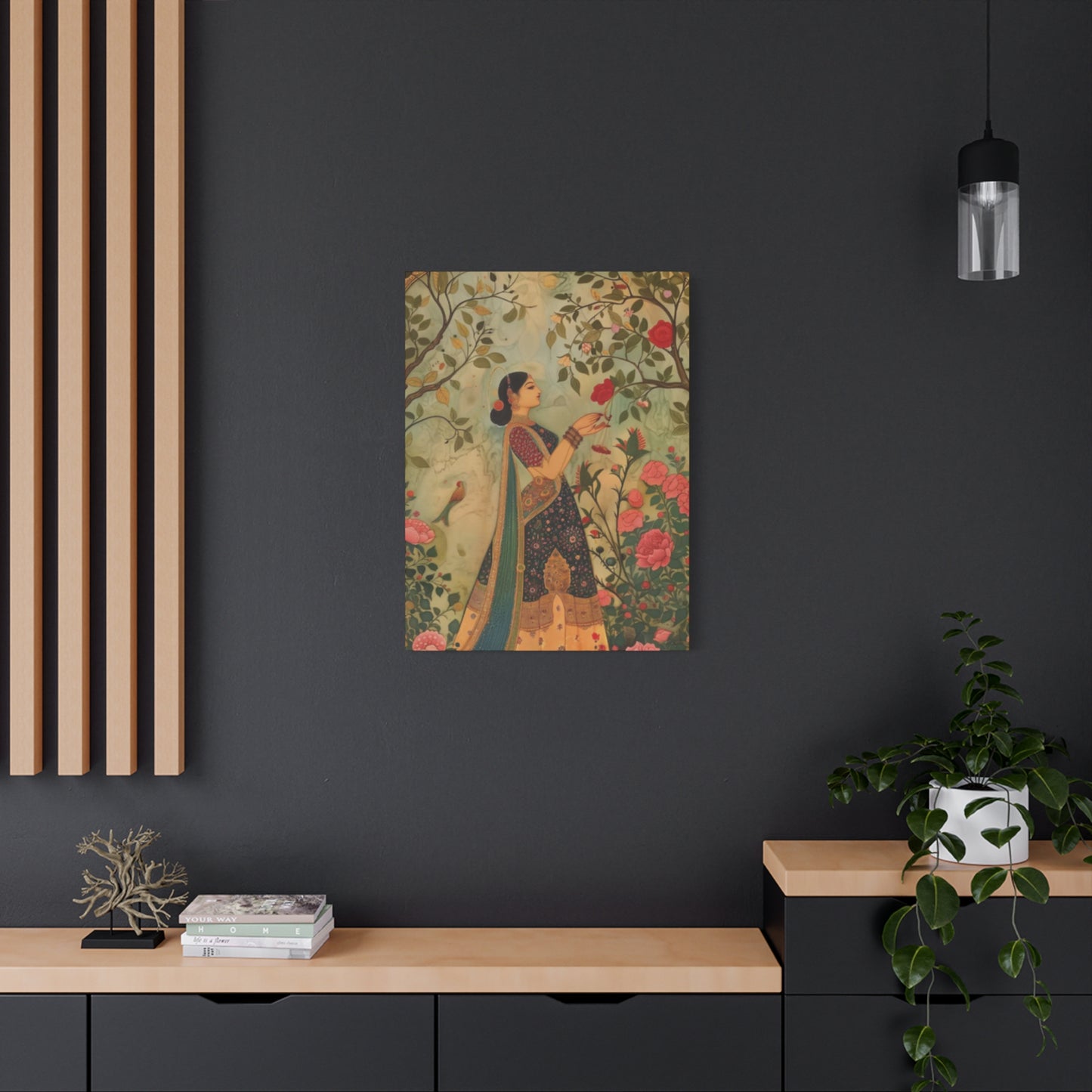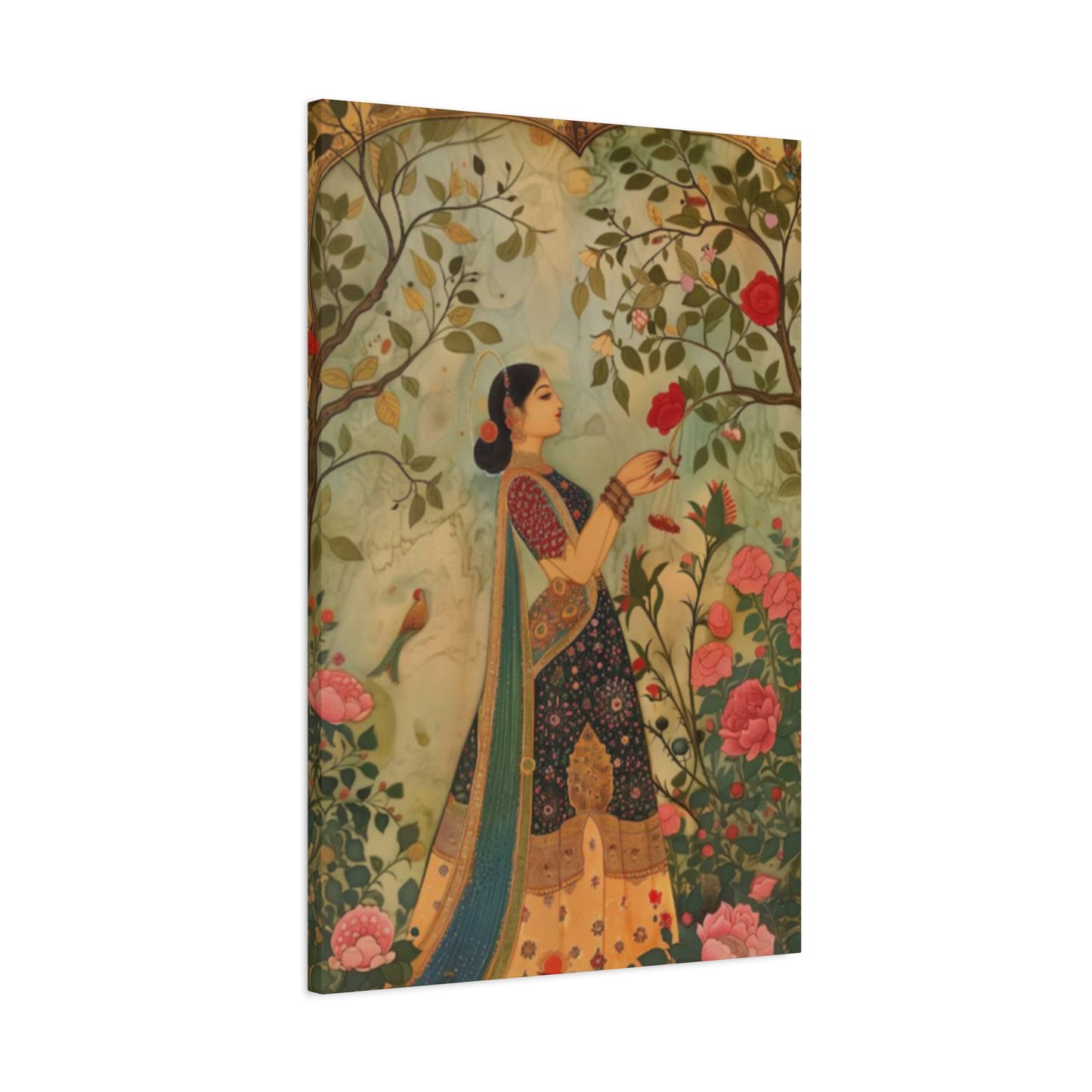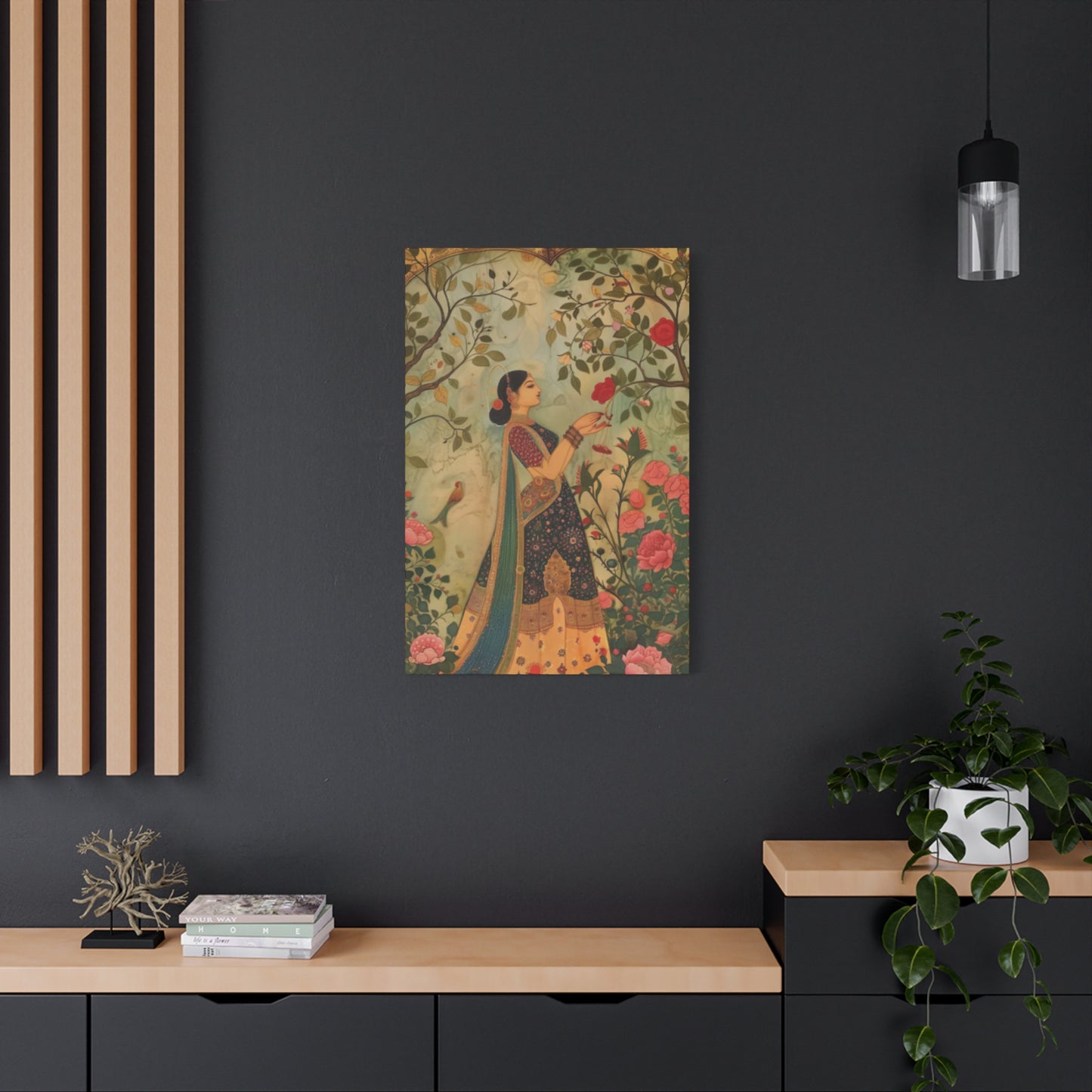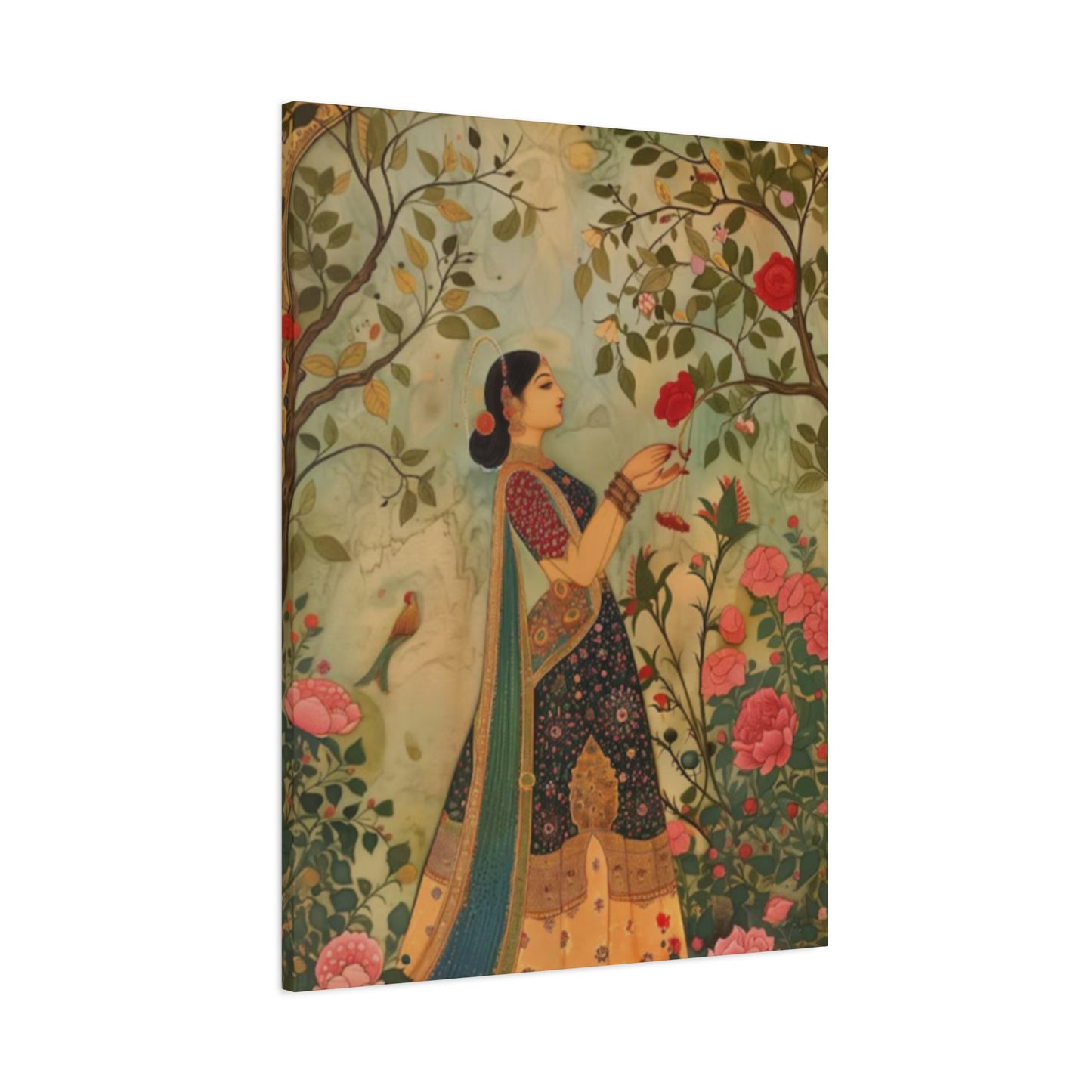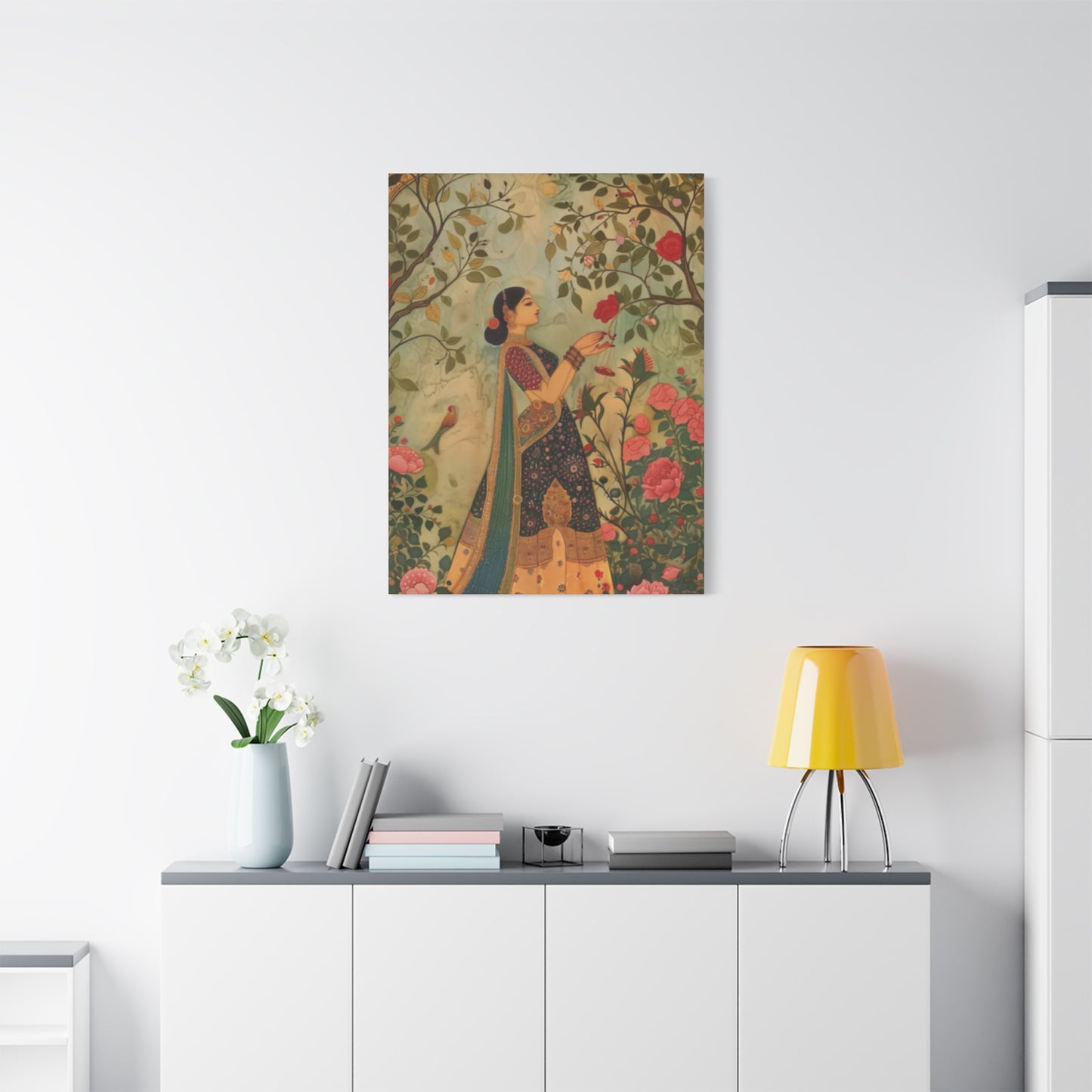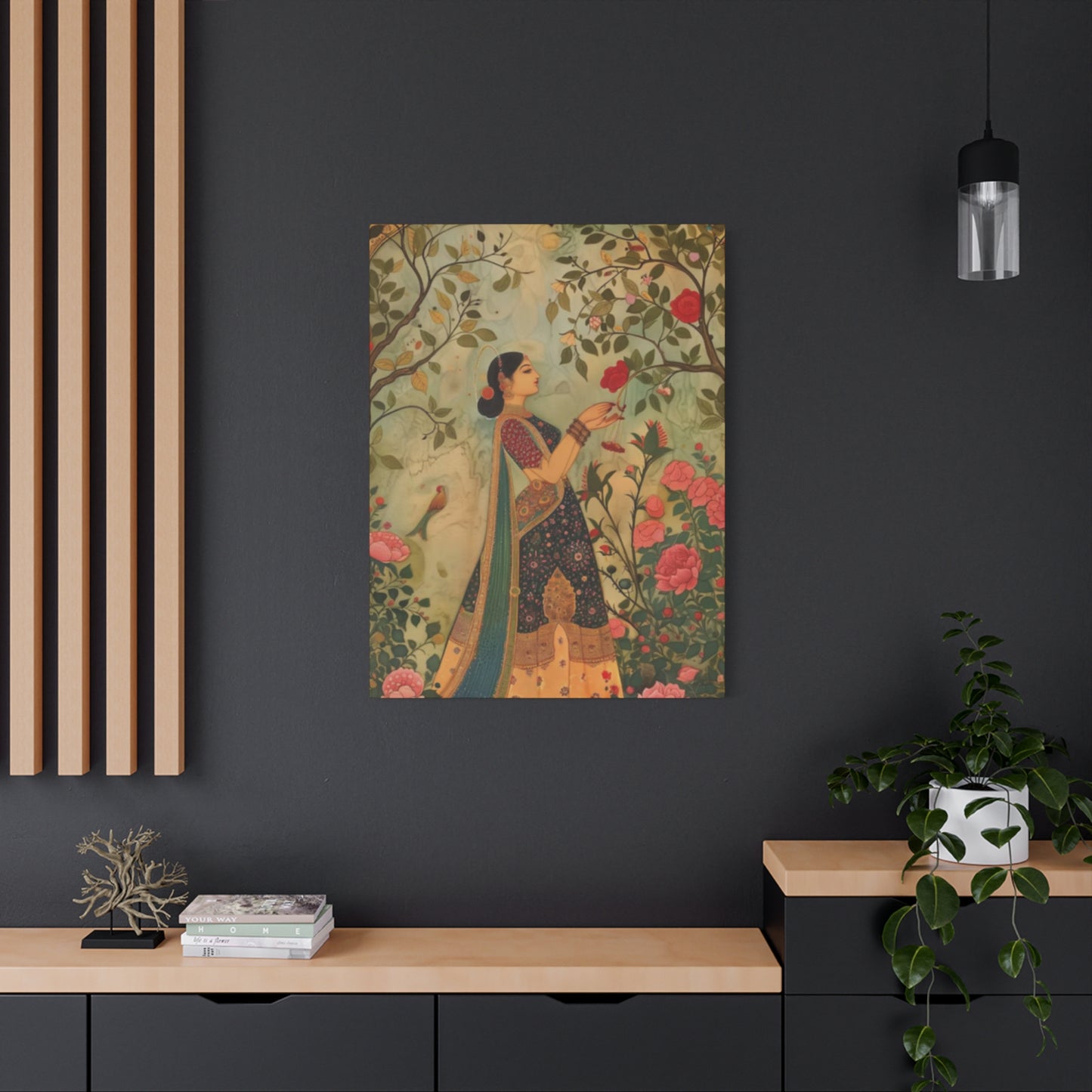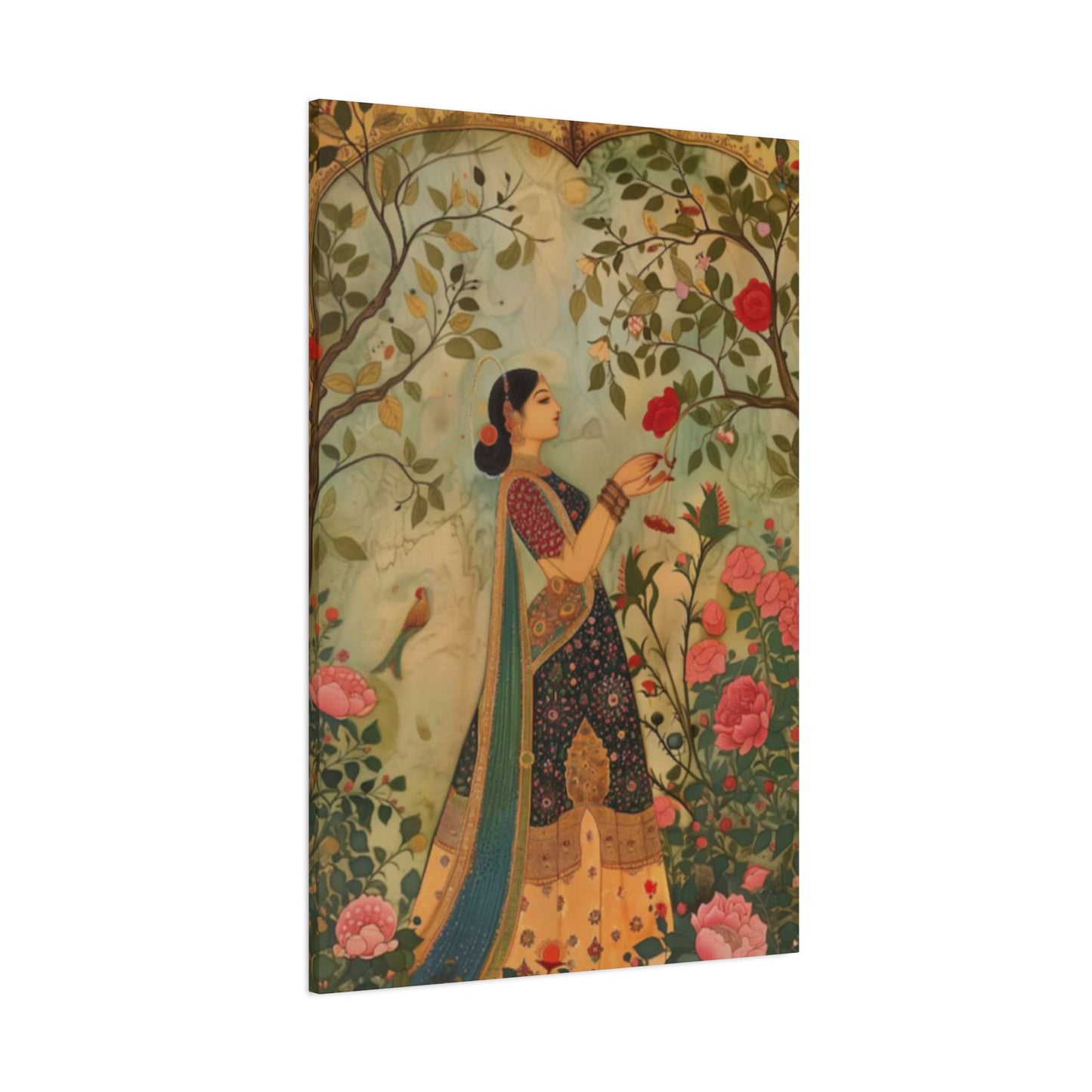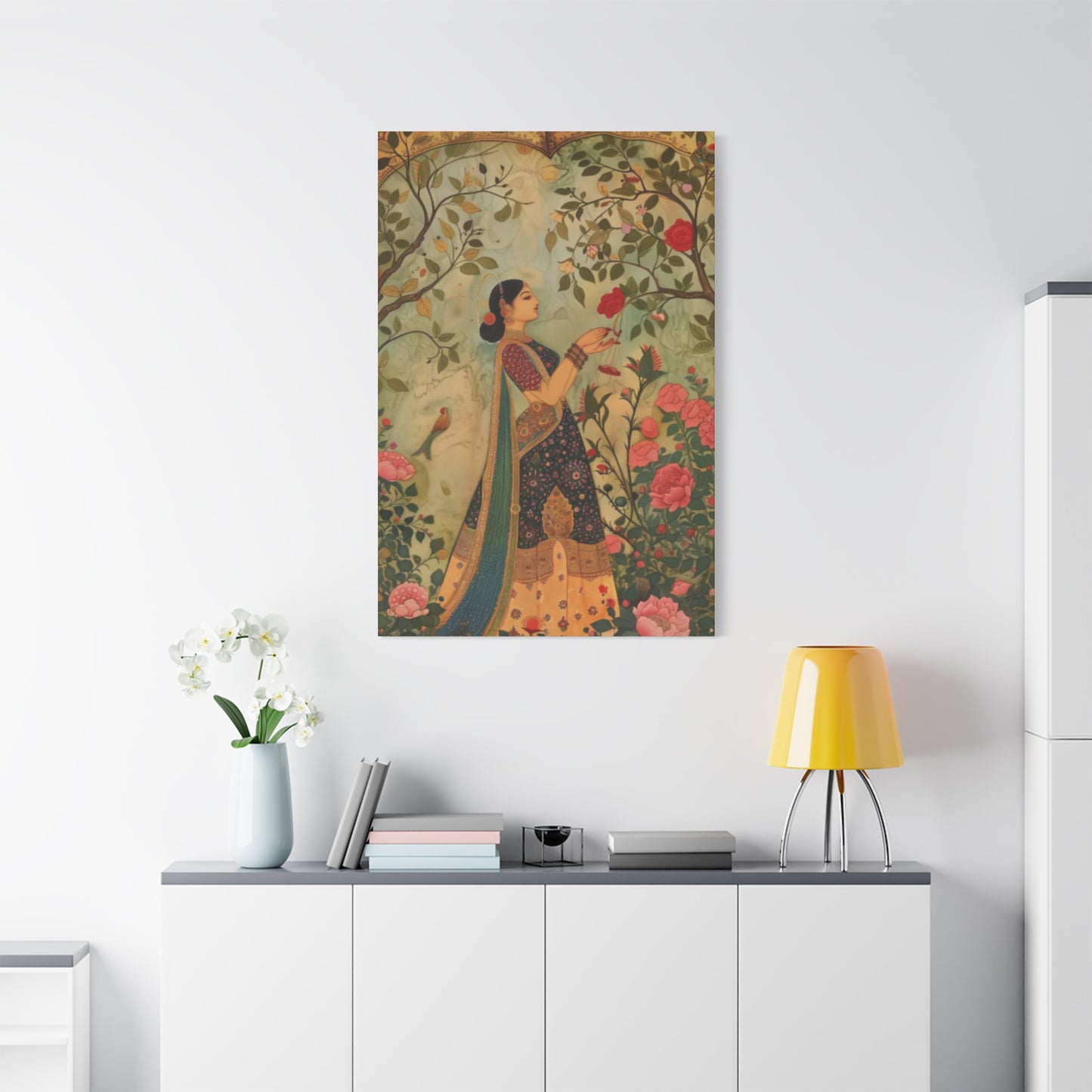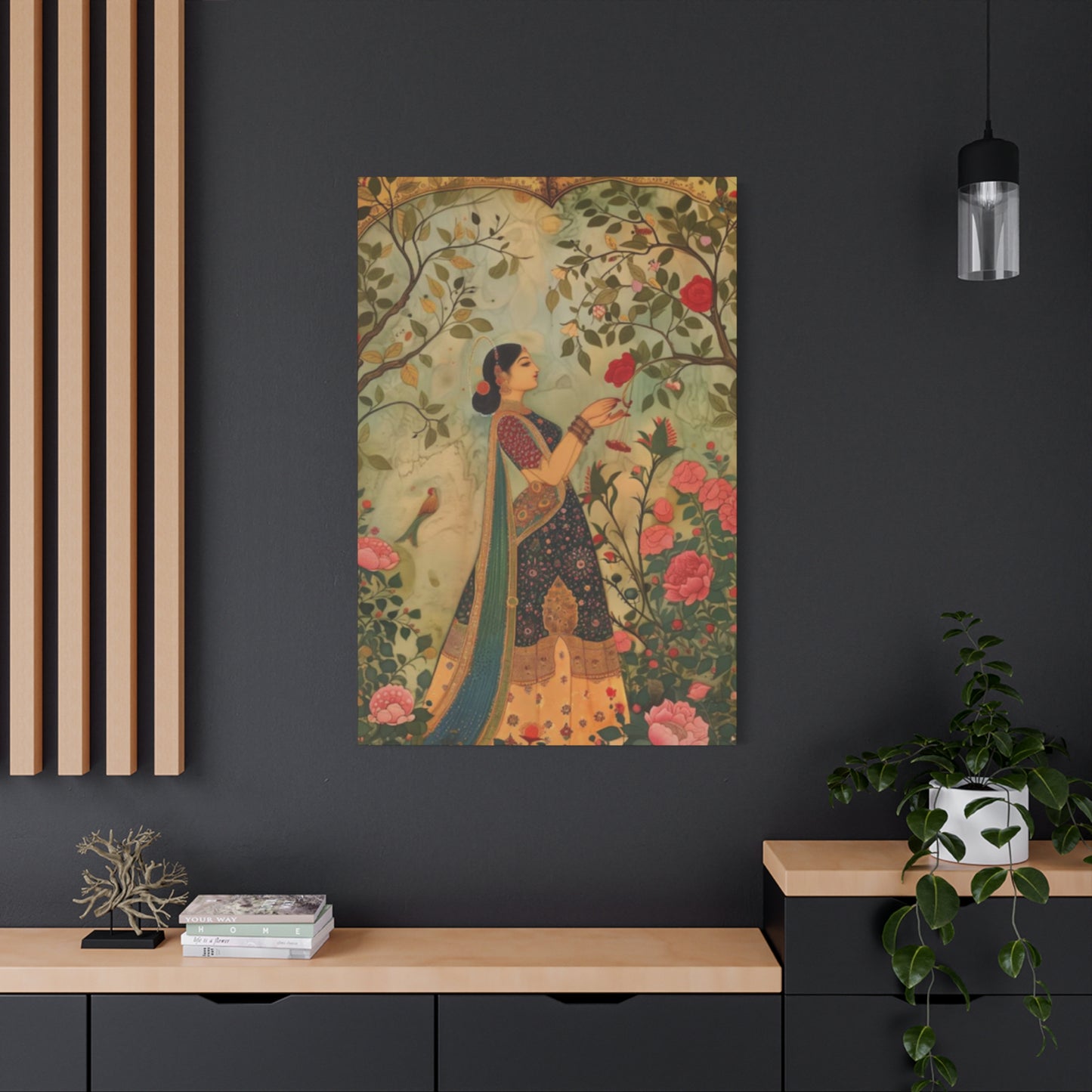Serenity in Bloom: Beautiful Indian Women in Garden Wall Art
The artistic representation of women in garden environments has captivated audiences for centuries, creating a timeless fusion of feminine grace and natural beauty. This art form transcends mere decoration, offering profound emotional resonance and visual storytelling that speaks to the human soul. From classical paintings to contemporary digital art, the imagery of women surrounded by blooming flowers, lush greenery, and peaceful outdoor spaces continues to inspire artists and collectors alike.
The appeal of women in garden settings stems from the inherent connection between femininity and nature's nurturing qualities. Gardens represent growth, beauty, serenity, and renewal, while the feminine presence adds depth, emotion, and human connection to these natural spaces. This combination creates artwork that is both aesthetically pleasing and emotionally meaningful, making it a popular choice for home decoration, gallery exhibitions, and personal collections.
Throughout history, artists have used garden settings to showcase the beauty and complexity of women, creating compositions that celebrate both natural and feminine elements. These artworks often feature women in moments of contemplation, joy, or peaceful interaction with their surroundings, capturing the essence of harmony between human beings and the natural world.
Women in Blooming Gardens
The depiction of women in blooming gardens represents one of the most beloved themes in art history. These compositions typically feature female figures surrounded by abundant flowers in full bloom, creating scenes of extraordinary beauty and vibrancy. The blooming garden serves as both backdrop and metaphor, symbolizing fertility, growth, and the cyclical nature of life.
Artists working with this theme often employ rich color palettes that emphasize the contrast between the soft tones of feminine beauty and the bold, vibrant hues of flowering plants. The interplay between these elements creates visual depth and emotional resonance that draws viewers into the scene. Women portrayed in blooming gardens are frequently shown in moments of quiet contemplation or gentle interaction with the flowers, suggesting a deep connection between the female spirit and nature's creative force.
The artistic tradition of placing women in blooming gardens dates back to ancient civilizations, where such imagery was associated with goddesses of fertility and nature. Renaissance masters elevated this theme to new heights, creating masterpieces that combined technical excellence with profound symbolism. The blooming garden became a metaphor for feminine beauty at its peak, while also representing the potential for growth and transformation.
Modern interpretations of women in blooming gardens continue to evolve, with contemporary artists bringing fresh perspectives to this classic theme. Digital art, photography, and mixed media approaches allow for innovative presentations that maintain the emotional core of the subject while introducing new visual elements. The enduring popularity of this theme demonstrates its universal appeal and the timeless connection between feminine beauty and natural abundance.
The psychological impact of viewing women in blooming gardens cannot be understated. These images evoke feelings of peace, beauty, and connection to nature that many people find deeply satisfying. The presence of the female figure adds a human element that makes the garden setting more relatable and emotionally engaging, creating artwork that serves both decorative and therapeutic purposes.
Serene Garden Portraits of Women
Serene garden portraits of women capture intimate moments of tranquility and reflection, presenting female subjects in peaceful outdoor environments that emphasize inner calm and natural beauty. These portraits differ from more dynamic garden scenes by focusing on the quiet, contemplative aspects of the human experience in natural settings.
The artistic approach to serene garden portraits often emphasizes soft lighting, gentle poses, and harmonious color schemes that create an atmosphere of peace and serenity. Artists working in this style typically choose garden settings that complement the mood they wish to convey, selecting backgrounds with subtle textures and muted tones that enhance rather than compete with the portrait subject.
Composition plays a crucial role in creating effective serene garden portraits. The placement of the female figure within the garden environment requires careful consideration of balance, proportion, and visual flow. Artists often use natural elements such as flowering branches, garden paths, or water features to frame their subjects, creating depth and visual interest while maintaining the overall sense of tranquility.
The lighting in serene garden portraits is particularly important, as it sets the mood and defines the relationship between the subject and her environment. Soft, diffused natural light is often preferred, as it creates gentle shadows and highlights that enhance the feminine features while maintaining the peaceful atmosphere of the garden setting.
Color selection in serene garden portraits typically favors earth tones, pastels, and muted hues that contribute to the overall sense of calm. The artist's palette should reflect the serenity of the scene, avoiding harsh contrasts or overly vibrant colors that might disturb the peaceful mood. The goal is to create a harmonious blend of colors that supports the contemplative nature of the portrait.
The emotional impact of serene garden portraits lies in their ability to convey a sense of inner peace and connection with nature. Viewers often find these images calming and restorative, making them popular choices for bedroom decor, meditation spaces, and therapeutic environments. The combination of feminine beauty and natural serenity creates artwork that speaks to the human need for peace and connection with the natural world.
Women Surrounded by Nature
The artistic representation of women surrounded by nature encompasses a broad range of natural environments, from dense forests and meadows to seaside landscapes and mountain vistas. This theme explores the relationship between femininity and the wild, untamed aspects of the natural world, often presenting women as integral parts of the ecosystem rather than separate from it.
Artists working with this theme often emphasize the interconnectedness of human beings and nature, presenting female figures who appear comfortable and at home in natural settings. The women in these artworks may be shown walking through forests, sitting by streams, or standing in open meadows, always portrayed as harmonious elements within the larger natural composition.
The technical challenges of depicting women surrounded by nature require artists to master the representation of complex natural forms while maintaining focus on the human subject. This involves careful attention to the details of plant life, terrain, weather conditions, and lighting, all while ensuring that these elements support rather than overwhelm the feminine presence in the composition.
Color and texture play vital roles in successfully depicting women surrounded by nature. The artist must create a believable natural environment using appropriate colors and textures for different seasons, times of day, and geographical locations. The female figure must be integrated into this environment through careful attention to lighting, color harmony, and compositional balance.
The symbolic significance of women surrounded by nature often relates to themes of environmental consciousness, spiritual connection, and the primal relationship between humanity and the earth. These artworks can serve as reminders of our dependence on and responsibility to the natural world, while also celebrating the beauty and strength of both women and nature.
Contemporary interpretations of women surrounded by nature often incorporate environmental themes and ecological awareness. Artists may use their work to highlight conservation issues, climate change concerns, or the importance of preserving natural habitats. This adds a layer of social and environmental commentary to the traditional aesthetic appreciation of feminine beauty and natural landscapes.
Garden Moments Captured in Art
The concept of capturing garden moments in art focuses on the fleeting, ephemeral experiences that occur in garden settings. These might include the brief bloom of a particular flower, the play of sunlight through leaves, or a moment of quiet contemplation by a female figure in the garden. Artists working in this style aim to freeze these precious moments in time, creating lasting records of temporary beauty.
The technical challenge of capturing garden moments lies in the artist's ability to convey the sense of temporality and movement within a static medium. This requires mastery of techniques that suggest the passage of time, the movement of air, and the changing qualities of light throughout the day. The female presence in these moments adds emotional depth and human connection to the scene.
Garden moments often involve the interaction between women and specific elements within the garden environment. This might include a woman tending to flowers, reading in a garden alcove, or simply pausing to appreciate the beauty around her. These interactions create narrative elements that make the artwork more engaging and relatable to viewers.
The seasonal nature of gardens provides rich material for artists interested in capturing specific moments. Spring blossoms, summer abundance, autumn colors, and winter dormancy each offer unique opportunities to portray women in garden settings that reflect the cyclical nature of both life and the natural world.
Lighting plays a crucial role in capturing garden moments, as different times of day and weather conditions create varying moods and atmospheres. Morning light might create a sense of fresh beginning, while evening light might evoke feelings of peaceful reflection. Artists must be skilled in representing these subtle variations to effectively capture the essence of specific garden moments.
The emotional resonance of captured garden moments comes from their ability to connect viewers with their own experiences of beauty and tranquility in natural settings. These artworks serve as reminders of the importance of taking time to appreciate the small moments of beauty that surround us, particularly in the company of natural environments and the presence of feminine grace.
Women Among Flowers Wall Art
Wall art featuring women among flowers has become increasingly popular in contemporary interior design, offering a perfect blend of natural beauty and feminine elegance that complements a wide range of decorative styles. This type of artwork serves both aesthetic and emotional functions, bringing the beauty of gardens and feminine presence into indoor spaces.
The design considerations for women among flowers wall art must take into account the intended display environment, viewing distance, and relationship to other decorative elements in the space. Artists and designers working in this field must create compositions that work effectively at various scales and in different lighting conditions.
Color coordination is particularly important in wall art applications, as the artwork must harmonize with existing interior color schemes while maintaining its own visual impact. Women among flowers wall art often features carefully balanced palettes that can complement neutral interior designs while adding visual interest and emotional warmth to the space.
The compositional approach to women among flowers wall art varies depending on the intended application. Single large pieces might feature dramatic compositions with bold visual elements, while series of smaller pieces might focus on subtle variations of theme and mood. The arrangement of multiple pieces can create visual narratives that unfold across wall spaces.
The psychological impact of women among flowers wall art in residential and commercial spaces is significant. These images can create feelings of calm, beauty, and connection to nature that enhance the overall atmosphere of interior environments. The presence of feminine figures adds human warmth and relatability that purely floral or landscape art might lack.
Contemporary production methods for wall art have expanded the possibilities for women among flowers imagery. Digital printing, canvas reproduction, and mixed media approaches allow for high-quality reproductions of original artworks as well as entirely new digital creations. This has made beautiful art featuring women among flowers more accessible to a broader audience while maintaining artistic quality and visual impact.
Tranquil Garden Scenes with Women
Tranquil garden scenes featuring women represent a specialized genre of art that emphasizes peace, serenity, and the restorative power of natural environments. These scenes typically feature carefully composed gardens designed to evoke feelings of calm and relaxation, with female figures integrated into the peaceful setting.
The artistic challenge of creating tranquil garden scenes lies in the careful balance of all visual elements to support the overall mood of serenity. This includes the selection of appropriate plant materials, garden features, architectural elements, and lighting conditions that contribute to the peaceful atmosphere. The female presence must enhance rather than disturb this tranquility.
Garden design principles play an important role in creating convincing tranquil scenes. Artists must understand how real gardens create feelings of peace and incorporate these principles into their artistic compositions. This might include the use of water features, curved pathways, secluded seating areas, and carefully selected plant materials that create natural sanctuaries.
The representation of women in tranquil garden scenes often emphasizes contemplative poses and peaceful expressions that align with the overall mood of the composition. The clothing, posture, and activities of the female figures should contribute to the sense of serenity rather than creating visual tension or distraction.
Color psychology plays a significant role in creating tranquil garden scenes. Cool blues and greens, soft earth tones, and muted pastels are often employed to create the visual foundation for peaceful scenes. The artist must understand how different colors affect emotional responses and use this knowledge to support the tranquil mood of the composition.
The market for tranquil garden scenes with women reflects a growing interest in wellness, mindfulness, and the therapeutic value of art. These images are particularly popular in healthcare environments, meditation spaces, spas, and residential areas where relaxation and stress reduction are priorities. The combination of natural beauty and feminine presence creates artwork that serves both decorative and therapeutic functions.
Elegant Women in Outdoor Art
The portrayal of elegant women in outdoor settings represents a sophisticated approach to combining fashion, feminine grace, and natural beauty in artistic compositions. This genre emphasizes the refinement and poise of the female subjects while showcasing their interaction with outdoor environments, creating artwork that celebrates both human elegance and natural splendor.
Elegance in outdoor art requires careful attention to the details of clothing, posture, and styling that distinguish these works from more casual or naturalistic portrayals. The women depicted often wear refined clothing appropriate to outdoor settings, with careful attention paid to how fabrics move and respond to natural lighting and environmental conditions.
The selection of outdoor settings for elegant women must complement the sophisticated nature of the subjects without overwhelming them. Formal gardens, well-maintained landscapes, and architecturally significant outdoor spaces often provide appropriate backgrounds for these compositions. The environment should enhance the elegance of the female figures rather than competing with them for visual attention.
Lighting techniques for elegant outdoor art often emphasize the interplay between natural and artificial lighting sources. The goal is to create illumination that enhances the refined qualities of the subjects while maintaining the authentic feel of outdoor environments. This might involve the artistic representation of golden hour lighting, filtered sunlight, or evening illumination.
The compositional approach to elegant women in outdoor art often employs classical principles of balance, proportion, and visual hierarchy. The arrangement of elements within the frame should guide the viewer's attention while creating a sense of harmony and sophistication that reflects the elegant nature of the subject matter.
Contemporary applications of elegant women in outdoor art include high-end fashion photography, luxury brand advertising, and fine art photography that celebrates both feminine beauty and environmental aesthetics. These works often serve commercial purposes while maintaining artistic integrity and visual appeal.
Women Embracing Garden Beauty
The theme of women embracing garden beauty captures moments of joy, appreciation, and emotional connection between female figures and their garden environments. This artistic approach emphasizes the positive emotional responses that gardens can evoke, presenting women in states of happiness, wonder, and deep appreciation for natural beauty.
The artistic challenge of depicting women embracing garden beauty lies in conveying genuine emotion and authentic interaction between the human subjects and their environment. This requires careful observation of how people actually respond to beautiful natural settings and the ability to translate these observations into compelling visual compositions.
Body language and facial expressions are crucial elements in successfully portraying women embracing garden beauty. The artist must capture subtle cues that suggest genuine appreciation, joy, or wonder, avoiding cliched or artificial-looking poses that might undermine the authenticity of the emotional connection being depicted.
The garden environments featured in these artworks must be sufficiently beautiful and engaging to justify the emotional responses of the female subjects. This requires artistic skill in depicting the most attractive aspects of garden design, from spectacular flower displays to peaceful water features and charming architectural elements.
The seasonal timing of women embracing garden beauty often focuses on peak moments of garden splendor, such as spring flowering periods, summer abundance, or autumn color displays. These timing choices help justify the strong emotional responses depicted and create more visually compelling compositions.
The psychological impact of viewing women embracing garden beauty can be quite positive, as these images tend to evoke similar feelings of appreciation and joy in viewers. The artwork serves as a reminder of the emotional benefits of spending time in beautiful natural environments and can inspire viewers to seek out similar experiences in their own lives.
Nature-Inspired Female Wall Art
Nature-inspired female wall art represents a broad category of artwork that incorporates natural elements, patterns, and themes into the representation of women. This approach can range from literal depictions of women in natural settings to more abstract interpretations that use natural forms and motifs to enhance feminine imagery.
The design flexibility of nature-inspired female wall art allows artists to explore a wide range of creative approaches while maintaining coherent thematic focus. Natural elements might include floral patterns, leaf motifs, water imagery, or animal symbolism integrated with feminine figures to create unique artistic expressions.
The application of nature-inspired female wall art in interior design offers opportunities to bring organic elements into modern living spaces while celebrating feminine beauty. These artworks can serve as focal points that connect interior environments with the natural world, creating spaces that feel more harmonious and balanced.
Color palettes for nature-inspired female wall art often draw from natural sources, incorporating earth tones, plant colors, sky hues, and water reflections into artistic compositions. The use of natural color relationships can create artwork that feels organic and harmonious while maintaining visual interest and aesthetic appeal.
The symbolic content of nature-inspired female wall art can explore themes of growth, renewal, connection, and environmental awareness. The artwork might convey messages about the relationship between humanity and nature, the importance of environmental stewardship, or the spiritual connections between women and the natural world.
Contemporary production techniques for nature-inspired female wall art include digital art creation, mixed media approaches, and sustainable art practices that align with environmental themes. Artists might use recycled materials, natural pigments, or eco-friendly production methods to create artwork that supports its environmental message through its creation process.
Women Enjoying Garden Spaces
The artistic representation of women enjoying garden spaces focuses on the recreational and leisure aspects of garden environments. These artworks typically show women engaged in various garden-related activities or simply relaxing and finding pleasure in beautiful outdoor settings.
The range of activities depicted in women enjoying garden spaces can include reading, painting, socializing, exercising, or simply sitting and appreciating the surroundings. Each activity requires different compositional approaches and technical considerations to effectively convey the enjoyment and engagement of the female subjects.
Garden space design plays an important role in these artworks, as the environment must be conducive to the activities and enjoyment being depicted. This might include comfortable seating areas, shaded spaces, interesting plantings, or recreational features that support various forms of garden enjoyment.
The seasonal considerations for depicting women enjoying garden spaces affect both the activities shown and the overall mood of the compositions. Spring and summer scenes might emphasize active enjoyment and vibrant colors, while autumn and winter scenes might focus on quieter forms of appreciation and more subdued palettes.
The social aspects of women enjoying garden spaces can include depictions of friends or family members sharing garden experiences together. These group compositions require careful attention to interpersonal dynamics, conversational body language, and the ways that multiple figures can be arranged within garden settings.
The commercial applications of women enjoying garden spaces include advertising for outdoor furniture, garden design services, lifestyle brands, and residential developments. These images help communicate the lifestyle benefits of beautiful outdoor spaces and can inspire viewers to create their own enjoyable garden environments.
Peaceful Women in Floral Art
Peaceful women in floral art combines the calming qualities of floral imagery with the serene presence of feminine figures to create artwork that emphasizes tranquility and emotional balance. This genre specifically focuses on the peaceful, meditative qualities that both flowers and feminine presence can bring to artistic compositions.
The selection of floral elements for peaceful compositions requires consideration of which flowers and arrangements best support feelings of calm and serenity. Soft, flowing flower forms, gentle colors, and natural arrangements typically work better than bold, dramatic floral displays that might create visual tension rather than peace.
The portrayal of peaceful women in floral settings often emphasizes relaxed poses, gentle expressions, and clothing choices that contribute to the overall sense of calm. The goal is to create human figures that harmonize with the peaceful floral environment rather than creating contrast or visual excitement.
The artistic techniques used in peaceful women in floral art often include soft brushwork, blended colors, and gentle transitions between different elements of the composition. These technical approaches help create the visual unity and calm atmosphere that characterizes this genre of artwork.
The therapeutic applications of peaceful women in floral art make these images particularly valuable in healthcare settings, therapy offices, and personal spaces designed for relaxation and stress relief. The combination of peaceful feminine presence and beautiful flowers can have calming psychological effects that support healing and wellness.
The market demand for peaceful women in floral art reflects growing interest in wellness, mindfulness, and the therapeutic value of beautiful imagery. These artworks serve both decorative and functional purposes, enhancing living spaces while contributing to the emotional well-being of viewers.
Garden Walks: Women in Art
The artistic theme of garden walks featuring women captures the dynamic experience of moving through garden spaces, emphasizing the journey and discovery aspects of garden appreciation. This approach differs from static garden scenes by incorporating movement, progression, and the unfolding revelation of garden beauty.
The compositional challenges of depicting garden walks include creating a sense of movement and direction while maintaining visual balance and interest throughout the composition. The pathway itself becomes an important design element, guiding both the depicted figure and the viewer's eye through the garden space.
The sequential nature of garden walks can be expressed through single compositions that suggest movement or through series of artworks that show progression through different garden areas. Each approach offers different opportunities for storytelling and visual development of the garden walk theme.
The seasonal timing of garden walks affects both the visual appearance of the garden environment and the appropriate clothing and activities of the female figures. Spring walks might emphasize discovery of new growth, while autumn walks might focus on the appreciation of changing colors and the preparation for seasonal transitions.
The emotional journey of garden walks can parallel the physical journey through garden spaces. The artwork might show moments of surprise, contemplation, joy, or peaceful reflection as the female figures encounter different garden features and experiences along their walk.
The educational aspects of garden walks in art can introduce viewers to garden design principles, plant identification, and the seasonal cycles of garden environments. The artwork serves as both aesthetic experience and informal education about the natural world and designed landscapes.
Women and Blossom-Themed Art
Women and blossom-themed art focuses specifically on the relationship between feminine figures and flowering plants, particularly during peak blooming periods. This theme emphasizes the ephemeral nature of both feminine beauty and flower blossoms, creating artwork that celebrates temporary perfection and natural cycles.
The timing of blossom-themed art is crucial, as it typically focuses on the brief periods when flowers are at their peak beauty. This might include spring cherry blossoms, summer rose blooms, or any other flowering period that represents the height of natural beauty and abundance.
The symbolic associations between women and blossoms have deep cultural and historical roots, with connections to themes of youth, beauty, fertility, and the cyclical nature of life. Artists working in this theme must be aware of these associations while creating their own unique interpretations and expressions.
The technical challenges of depicting blossoms accurately require detailed knowledge of flower structure, color, and growth patterns. The artist must be able to represent different types of blossoms convincingly while integrating them effectively with human figures in the composition.
The color relationships between feminine skin tones and blossom colors require careful consideration to create harmonious compositions. The artist must balance the desire to showcase both the beauty of the blossoms and the attractiveness of the female figures without allowing one element to overwhelm the other.
The commercial applications of women and blossom-themed art include spring marketing campaigns, beauty product advertising, wedding imagery, and seasonal decorative art. The association between feminine beauty and flower blossoms makes this theme particularly effective for products and services targeting female consumers.
Romantic Garden Scenes with Women
Romantic garden scenes featuring women emphasize the emotional and atmospheric qualities that make garden environments particularly conducive to romantic feelings and experiences. These artworks often focus on the softer, more intimate aspects of garden design and their interaction with feminine presence.
The design elements that contribute to romantic garden scenes include features such as secluded seating areas, fragrant flowers, soft lighting, and intimate scale spaces that encourage close connection with the environment. The female figures in these scenes often interact with these romantic elements in ways that enhance the overall mood.
The lighting in romantic garden scenes typically emphasizes warm, soft illumination that creates intimate atmospheres. This might include golden hour lighting, candlelight, moonlight, or the filtered light that comes through garden pergolas and arbors. The quality of light significantly affects the romantic mood of the composition.
The seasonal timing of romantic garden scenes often focuses on periods of peak garden beauty, particularly spring and early summer when many flowers are in bloom and the weather encourages outdoor activities. The seasonal choice affects both the visual appearance and the emotional associations of the scene.
The clothing and styling of women in romantic garden scenes should complement the overall mood while being appropriate for outdoor environments. Flowing fabrics, soft colors, and feminine details often work well with romantic garden settings, while overly formal or casual clothing might disrupt the desired atmosphere.
The market for romantic garden scenes includes wedding photography, engagement portraits, romantic greeting cards, and decorative art for bedrooms and intimate living spaces. The emotional appeal of these images makes them popular for personal and commercial applications related to love and relationships.
Women in Lush Greenery Art
The artistic representation of women in lush greenery emphasizes the abundant, verdant aspects of natural environments and their interaction with feminine figures. This theme focuses on the visual richness and emotional impact of dense, healthy plant growth and its relationship to human presence.
The technical challenges of depicting lush greenery require mastery of various green tones, textures, and forms that occur in dense plant environments. The artist must be able to differentiate between different types of foliage while creating cohesive compositions that don't become visually overwhelming or confusing.
The compositional approach to women in lush greenery must balance the desire to showcase the abundance of plant life with the need to maintain focus on the human figures. This might involve using techniques such as selective focus, strategic lighting, or careful placement of figures to create visual hierarchy within complex natural environments.
The seasonal timing of lush greenery art typically focuses on late spring and summer periods when plant growth is most abundant and visually impressive. The timing choice affects the specific types of plants depicted and the overall energy and vitality of the composition.
The emotional impact of lush greenery environments can be quite positive, suggesting abundance, health, vitality, and connection to thriving natural ecosystems. The presence of women in these environments can enhance these positive associations while adding human warmth and relatability to the scene.
The environmental messaging in women in lush greenery art can support themes of conservation, sustainability, and the importance of healthy ecosystems. The artwork might serve as a reminder of what we stand to lose if we don't protect and nurture our natural environments.
Artistic Garden Portraits of Women
Artistic garden portraits represent a specialized form of portraiture that uses garden environments to enhance and complement the depiction of individual women. This approach combines the technical requirements of portrait photography or painting with the aesthetic opportunities provided by beautiful outdoor settings.
The portrait focus of this genre requires primary attention to the individual characteristics, personality, and beauty of the female subject, with the garden environment serving as a supportive backdrop rather than the primary subject. The challenge is creating garden settings that enhance rather than compete with the portrait subject.
The selection of appropriate garden backgrounds for portraits requires consideration of factors such as color harmony, visual complexity, and seasonal appropriateness. The background should complement the subject's coloring, clothing, and overall aesthetic while providing visual interest without distraction.
The lighting requirements for garden portraits often involve working with natural outdoor lighting conditions while achieving the precise illumination needed for effective portraiture. This might require supplemental lighting equipment or careful timing to take advantage of optimal natural lighting conditions.
The posing and directing of women in garden portrait settings requires understanding of both portrait techniques and the specific challenges of outdoor environments. The subject must be positioned to take advantage of the garden setting while maintaining the focus and intimacy that characterizes effective portraiture.
The commercial applications of artistic garden portraits include senior portraits, bridal photography, professional headshots, and fine art portraiture. The combination of individual beauty and natural surroundings creates images that are both personally meaningful and aesthetically appealing.
Women in Sunlit Gardens
The depiction of women in sunlit gardens emphasizes the transformative power of natural light in outdoor environments and its interaction with feminine beauty. Sunlight creates opportunities for dramatic lighting effects, warm color palettes, and the suggestion of vitality and energy that comes from bright, cheerful environments.
The technical challenges of representing sunlit gardens include managing high contrast lighting conditions, creating believable shadows and highlights, and depicting the way sunlight affects both plant materials and human subjects. The artist must understand how different lighting conditions affect color, form, and mood.
The time-of-day considerations for sunlit garden scenes affect both the quality of light and the activities that might realistically be depicted. Morning light might suggest fresh beginnings and gentle activities, while midday sun might emphasize energy and vitality, and afternoon light might create more dramatic and colorful effects.
The seasonal implications of sunlit gardens vary significantly, with different seasons providing different types of sunlight and garden conditions. Summer sunlight might emphasize abundance and vibrant colors, while winter sunlight might create more subtle effects with dormant plants and different atmospheric conditions.
The compositional opportunities provided by sunlight include the creation of dramatic shadows, backlighting effects, and the highlighting of specific elements within the garden environment. The artist can use these lighting effects to guide attention, create mood, and enhance the overall visual impact of the composition.
The psychological effects of viewing sunlit garden scenes tend to be positive and energizing, as bright natural lighting is associated with happiness, vitality, and well-being. The combination of feminine beauty and cheerful lighting creates artwork that can enhance mood and create positive emotional responses in viewers.
Female Figures in Garden Landscapes
The integration of female figures into garden landscapes represents a sophisticated approach to combining human presence with designed outdoor environments. This theme emphasizes the relationship between individual women and the broader garden context, creating compositions that celebrate both human and environmental beauty.
The scale relationships between female figures and garden landscapes require careful consideration to create believable and visually effective compositions. The figures must be appropriately sized for their environment while maintaining sufficient visual impact to serve their role in the overall composition.
The garden design principles that apply to landscape-scale compositions include considerations of proportion, rhythm, focal points, and visual flow that work with larger outdoor spaces. The artist must understand how these design principles affect the integration of human figures into landscape-scale environments.
The seasonal variations in garden landscapes provide opportunities for different moods, colors, and activities throughout the year. Each season offers unique characteristics that can be used to support different themes and emotional expressions in the artwork.
The architectural elements often present in garden landscapes, such as structures, pathways, and water features, provide opportunities for compositional interest and practical considerations for figure placement. These elements can be used to create visual anchors and support the integration of human figures into the landscape.
The environmental context of garden landscapes can support themes related to conservation, sustainable living, and the relationship between human habitation and natural environments. The artwork might communicate messages about how humans can live harmoniously within designed natural spaces.
Women in Vibrant Garden Art
Vibrant garden art featuring women emphasizes bold colors, energetic compositions, and the most visually exciting aspects of garden environments. This approach celebrates the dramatic potential of both feminine beauty and garden splendor, creating artwork that commands attention and creates strong emotional responses.
The color palette considerations for vibrant garden art typically include saturated hues, bold contrasts, and the most colorful flowers and plant materials available in garden settings. The artist must balance these strong colors while maintaining compositional harmony and avoiding visual chaos.
The energy level of vibrant garden art requires dynamic compositions that match the boldness of the color choices. This might include active poses, dramatic lighting, or compositional techniques that create visual movement and excitement throughout the artwork.
The plant material selection for vibrant garden scenes often focuses on the most colorful and dramatic flowering plants, such as tropical flowers, bold annuals, or spectacular perennial displays. The goal is to create garden environments that justify and support the vibrant artistic treatment.
The seasonal timing for vibrant garden art typically focuses on peak flowering periods when the most dramatic color displays are available. This might include late spring bulb displays, summer annual peaks, or autumn foliage seasons that provide bold color opportunities.
The market applications for vibrant garden art include energetic interior design schemes, commercial applications that require attention-grabbing imagery, and personal collections for people who prefer bold, dramatic artwork. The high energy of these compositions makes them particularly effective as focal points in interior design.
Tranquility and Femininity in Art
The artistic exploration of tranquility and femininity creates a specialized genre that focuses on the peaceful, calming aspects of feminine presence in natural or garden environments. This theme emphasizes qualities such as serenity, grace, contemplation, and emotional balance that are often associated with both femininity and peaceful natural settings.
The artistic techniques used to convey tranquility often include soft color palettes, gentle brushwork, harmonious compositions, and lighting that creates calm, peaceful atmospheres. The technical approach should support the emotional goals of creating feelings of peace and serenity in viewers.
The psychological associations between femininity and tranquility have deep cultural roots and can be explored through artwork that presents women as sources of calm and emotional balance. The garden or natural environment serves as a setting that supports and enhances these feminine qualities.
The compositional approaches to tranquility and femininity typically avoid dramatic contrasts, bold gestures, or elements that might create visual tension or excitement. Instead, the focus is on creating harmonious relationships between all elements of the composition that support the overall sense of peace.
The color psychology relevant to tranquility and femininity often emphasizes cool blues, soft greens, gentle earth tones, and pastel hues that are associated with calm and peaceful emotional states. The color choices should work together to create environments that feel restorative and emotionally balanced.
The therapeutic applications of tranquility and femininity art make these works particularly valuable in healthcare settings, meditation spaces, therapy offices, and residential environments designed for relaxation and stress relief. The artwork serves both aesthetic and functional purposes in supporting emotional well-being.
Garden Reflections: Women in Art
The theme of garden reflections featuring women can be interpreted both literally, as scenes involving reflective water surfaces in garden settings, and metaphorically, as artistic explorations of the contemplative and introspective aspects of garden experiences. Both interpretations offer rich opportunities for artistic expression and emotional communication.
The technical challenges of depicting literal reflections in garden settings require understanding of how light behaves on water surfaces and how reflections are affected by viewing angle, lighting conditions, and surface disturbance. The artist must be able to create convincing reflective effects while maintaining focus on the human subjects.
The compositional opportunities provided by reflective surfaces include the creation of symmetrical designs, the doubling of visual elements, and the opportunity to show subjects from multiple perspectives simultaneously. These effects can create visually interesting and emotionally resonant compositions.
The metaphorical interpretation of garden reflections might focus on moments of contemplation, self-discovery, or peaceful introspection that garden environments can encourage. The artwork might show women in thoughtful poses that suggest internal reflection and emotional processing.
The seasonal considerations for garden reflection scenes affect both the availability of reflective water surfaces and the types of reflection effects that can be achieved. Spring and summer might offer more active water features, while autumn and winter might provide different types of reflective opportunities.
The symbolic content of garden reflections can explore themes of self-knowledge, personal growth, the relationship between inner and outer beauty, and the way natural environments can encourage introspection and personal development. The artwork might communicate ideas about the value of taking time for reflection and self-examination.
Women in Secret Garden Scenes
The concept of secret garden scenes featuring women draws inspiration from the idea of hidden, private outdoor spaces that offer intimacy, mystery, and special beauty. These scenes typically emphasize the discovery and enjoyment of secluded garden areas that feel separate from the everyday world.
The design characteristics of secret garden scenes often include elements such as hidden entrances, enclosing vegetation, intimate scale, and features that create a sense of privacy and separation from the outside world. The garden should feel like a special, protected place that has been discovered rather than obviously displayed.
The mystery and discovery aspects of secret garden scenes can be conveyed through compositional techniques that suggest exploration, surprise, and the gradual revelation of hidden beauty. The female figures might be shown discovering or enjoying these special places, adding human interest to the mysterious garden environment.
Conclusion
Serenity in Bloom: Beautiful Indian Women in Garden Wall Art brings together the elegance of Indian feminine beauty and the tranquil charm of nature, creating a harmonious visual experience for interior spaces. These artworks depict women immersed in lush gardens, surrounded by vibrant flowers, greenery, and soft natural light, emphasizing serenity, contemplation, and cultural richness. Through detailed compositions, delicate color palettes, and expressive artistry, this style of wall art transforms interiors into peaceful, visually captivating environments that celebrate grace, nature, and authentic human emotion.
Incorporating Indian women in garden wall art into interiors allows spaces to feel serene, inspiring, and aesthetically engaging. In living rooms, bedrooms, or meditation spaces, these artworks serve as calming focal points that evoke mindfulness, reflection, and connection to nature. In creative studios or offices, they inspire creativity, emotional balance, and cultural appreciation. The versatility of this theme ensures it complements a variety of décor styles—from contemporary and minimalist to bohemian, eclectic, or traditional interiors—enhancing spaces with elegance, vibrancy, and thematic coherence.
The artistry behind Serenity in Bloom emphasizes detail, composition, and natural interaction. Artists capture expressive poses, gentle gestures, and the interplay of light and shadow across floral landscapes, highlighting the natural beauty of both the women and their surroundings. Techniques such as layered brushwork, soft gradients, and intricate detailing create depth, realism, and emotional resonance, making each piece more than decoration—it becomes a celebration of serenity, culture, and the beauty of life immersed in nature.
Ultimately, Beautiful Indian Women in Garden Wall Art elevates interiors by merging cultural storytelling with natural inspiration. It transforms walls into tranquil, visually compelling spaces that celebrate grace, mindfulness, and harmony with nature. By featuring this artwork, individuals can infuse their homes, offices, or creative environments with peace, elegance, and cultural richness—making it a timeless and captivating addition to any interior décor.

















